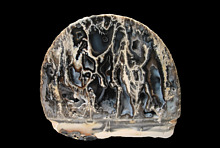Home PageAbout MindatThe Mindat ManualHistory of MindatCopyright StatusWho We AreContact UsAdvertise on Mindat
Donate to MindatCorporate SponsorshipSponsor a PageSponsored PagesMindat AdvertisersAdvertise on Mindat
Learning CenterWhat is a mineral?The most common minerals on earthInformation for EducatorsMindat ArticlesThe ElementsThe Rock H. Currier Digital LibraryGeologic Time
Minerals by PropertiesMinerals by ChemistryAdvanced Locality SearchRandom MineralRandom LocalitySearch by minIDLocalities Near MeSearch ArticlesSearch GlossaryMore Search Options
The Mindat ManualAdd a New PhotoRate PhotosLocality Edit ReportCoordinate Completion ReportAdd Glossary Item
Mining CompaniesStatisticsUsersMineral MuseumsClubs & OrganizationsMineral Shows & EventsThe Mindat DirectoryDevice SettingsThe Mineral Quiz
Photo SearchPhoto GalleriesSearch by ColorNew Photos TodayNew Photos YesterdayMembers' Photo GalleriesPast Photo of the Day GalleryPhotography
╳Discussions
💬 Home🔎 Search📅 LatestGroups
EducationOpen discussion area.Fakes & FraudsOpen discussion area.Field CollectingOpen discussion area.FossilsOpen discussion area.Gems and GemologyOpen discussion area.GeneralOpen discussion area.How to ContributeOpen discussion area.Identity HelpOpen discussion area.Improving Mindat.orgOpen discussion area.LocalitiesOpen discussion area.Lost and Stolen SpecimensOpen discussion area.MarketplaceOpen discussion area.MeteoritesOpen discussion area.Mindat ProductsOpen discussion area.Mineral ExchangesOpen discussion area.Mineral PhotographyOpen discussion area.Mineral ShowsOpen discussion area.Mineralogical ClassificationOpen discussion area.Mineralogy CourseOpen discussion area.MineralsOpen discussion area.Minerals and MuseumsOpen discussion area.PhotosOpen discussion area.Techniques for CollectorsOpen discussion area.The Rock H. Currier Digital LibraryOpen discussion area.UV MineralsOpen discussion area.Recent Images in Discussions
Techniques for Collectorshow is electroplating of magnetite in jade done

5th May 2009 19:43 UTCMichael Croxell
5th May 2009 20:01 UTCMatt Neuzil Expert

5th May 2009 23:35 UTCMichael Croxell

6th May 2009 02:52 UTCNH
You could make electrical contact between each mass of magnetite and the negative electrode (cathode) to reduce gold ions from the surrounding solution. You could use a gold anode that would be oxidized. They could also use those pen plating systems, but the idea is the same - have the negative electrode in contact with the magnetite. As you note, you wouldn't be able to hit all of the magnetite at once with this method as the jade is an insulator.

6th May 2009 03:52 UTCHoward Heitner
I found one reference which you might want to look at : European Patent Application, Publication No. 0 354 131 A2, by C. F. Schneider et al, entitled "Ferrite Particle Plating System and Electromagnetic Shielding", published on Feb. 7, 1990.
6th May 2009 03:59 UTCRock Currier Expert

6th May 2009 05:20 UTCNH

6th May 2009 14:15 UTCMichael Croxell
8th May 2009 12:58 UTCAlysson Rowan Expert

14th May 2009 06:20 UTCNT
-------------------------------------------------------
> I have seen a high-frequency inductive plating
> process at work. I'm not sure of the physics of
> it, but I gather that it will allow preferential
> electroplating on grains of suitable materials -
> I'm not sure if the suitability is conductivity,
> semi-conductivity or magnetic susceptibility.
I am really curios about this inductive plating. Could you please provide more details? Which company? Web links etc?
Thanks,
NT
14th May 2009 17:16 UTCAlysson Rowan Expert
I really don't have any more information at all, other than the fact that the equipment had been built in-house.

14th May 2009 18:14 UTCMichael Croxell

13th Nov 2009 13:50 UTCDenman
Dennis Armbruster
14th Nov 2009 08:33 UTCRay Hill Expert
There are also electroplating brushes that can be used to sort of brush on the electroplated metal to a metallic substance, using its electrical conductivity to make it work.

14th Nov 2009 12:53 UTCMichael Croxell




Mindat.org is an outreach project of the Hudson Institute of Mineralogy, a 501(c)(3) not-for-profit organization.
Copyright © mindat.org and the Hudson Institute of Mineralogy 1993-2024, except where stated. Most political location boundaries are © OpenStreetMap contributors. Mindat.org relies on the contributions of thousands of members and supporters. Founded in 2000 by Jolyon Ralph.
Privacy Policy - Terms & Conditions - Contact Us / DMCA issues - Report a bug/vulnerability Current server date and time: April 25, 2024 06:17:27
Copyright © mindat.org and the Hudson Institute of Mineralogy 1993-2024, except where stated. Most political location boundaries are © OpenStreetMap contributors. Mindat.org relies on the contributions of thousands of members and supporters. Founded in 2000 by Jolyon Ralph.
Privacy Policy - Terms & Conditions - Contact Us / DMCA issues - Report a bug/vulnerability Current server date and time: April 25, 2024 06:17:27










